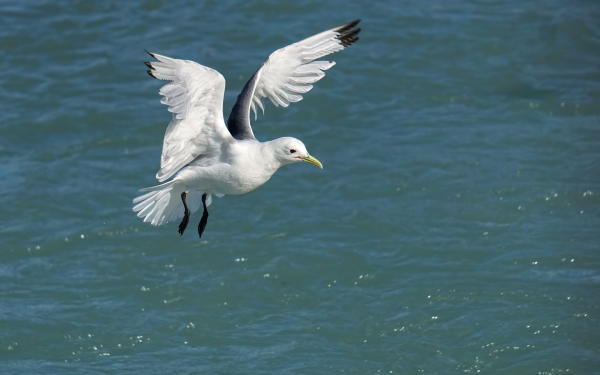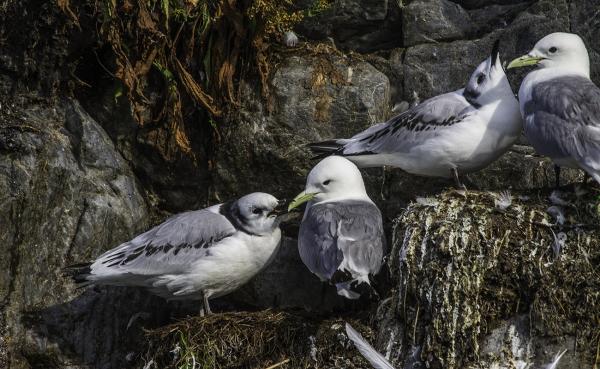Kittiwakes
Black-legged kittiwakes (Rissa tridactyla) are a common bird to spot in Valdez. Kittiwakes are in the Family Laridae (the gulls), making them relatives to some of Valdez's other shore birds, including mew gulls and glaucous-winged gulls. One distinctive feature of black-legged kittiwakes that helps distinguish them from the other gulls are their eponymous black legs and feet. Other gulls are more likely to have yellow or pink legs.

"Kittiwake on Approach" by Gary Minish
Behavior
Kittiwakes feed on invertebrates and small fish. A study conducted in the 1990s found that kittiwakes at Shoup Bay eat predominately herring and sand lance fish.
Kittiwakes are colonial birds that nest on cliffs on islands and along remote coastlines. Thousands of nests may be present in a colony. There are several kittiwake colonies in Prince William Sound, including one in Shoup Bay near Valdez. A study published in 2011 tracking black-legged kittiwakes in Prince William Sound (including those at Shoup Bay) determined that kittiwake colonies disperse during the winter months, with some migrating out along the coast or ocean, while others remain close to their summer breeding grounds.

Kittiwakes at Shoup Glacier. Photo from Valdez Outfitters
Safety and Etiquette
"Be respectful of nesting and denning areas, rookeries, and calving grounds. Well-meaning but intrusive visitors may cause parents to flee, leaving young vulnerable to the elements or to predators. Stay on designated trails whenever possible," Alaska Department of Fish and Game
Please be respectful of kittiwakes and all wildlife you see around Valdez. The the nesting grounds of kittiwakes and other shore birds should not be disturbed. We recommend consulting the Alaska Department of Fish and Game's article on Wildlife Viewing Ethics.
Viewing Locations
"Shoup Bay's 'kittiwake rock' with a population of 20,000 breeding birds is a noisy spectacle. In June and July, paddlers may observe adults and chicks if they approach quietly," Alaska Department of Fish and Game
Kittiwakes may be seen flying or feeding in a number of areas around Valdez, such as along the Duck Flats and surrounding areas. However the best viewing location is the kittiwake rookery in Shoup Bay. The bay can be reached at the end of the nine-mile long Shoup Bay Trail, though some sections of the hiking trail are overgrown with brush. An easier way to access the bay is with a local tour operator or boat charter. Bird watchers will appreciate that the rookery at Shoup Bay is one of the most accessible colonies of kittiwakes in Prince William Sound.
Black-legged Kittiwake Fact Sheet
From US Fish & Wildlife Service










